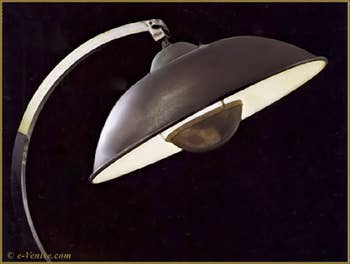Art Painters | Music | Literature | Video | Pictures
Painters Tintoretto | Titian | Canaletto | Fortuny | Albrecht Dürer |
Fortuny Museum Fortuny | Martinengo Orfei | Theatre | Clothes Fabrics | Photography Costume
Mariano Fortuny discovers indirect lighting
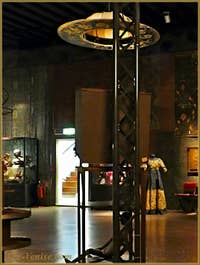
Silk Lamp Mariano Fortuny It was by happy chance, and thanks to his observant eye, that Mariano Fortuny discovered the light he was looking for to light the theatrical stage.
The direct lighting practised at the time did not satisfy him because it did not take into account the structure of the human eye, and therefore the effect on the spectator, who felt all the more artificial.
Here is what he wrote on the subject:
In the attic of the Palazzo Orfei where I was working, a ray of sunlight cut sharply across the floor.
When I installed the background paper, it was right in the area lit by the sun.
Metal table lamp by Mariano Fortuny I was surprised. The sheet of paper illuminated by the sun reflected back onto the low, dark ceiling the light I was looking for: not direct light, but reflected.”
Fortuny
In October 1900, he filed his first patent in Venice for “System of scenic illumination by indirect light”.
In December of the same year he took charge of the set and costume design for Tristan and Isolde at the Scala in Milan, trying to apply his discovery:
“I decided that the tree at the foot of which Tristan was dying would be transparent, in order to obtain a more intense twilight with gradual lights.”
And the press praised the magnificent effects achieved.
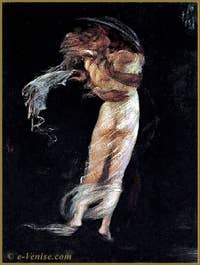
Mariano Fortuny The Valkyrie
Failed project with Gabriele d'Annunzio
Nor did his fine technical achievement escape the notice of his friend Gabriele d'Annunzio, who was writing his “Francesca da Rimini”, which was to be performed by Eleonora Duse, and he wanted to entrust the set design of this work to Mariano Fortuny.After several meetings, Mariano realised that d'Annunzio wanted him to handle the complete production of the sets and costumes, not just the models and drawings.
Faced with the unexpected scale of the task, Mariano eventually gave up.
In a pathetic letter telling him of his great distress, d'Annunzio asked him not to betray a promise made with such nobility, and told him that his abandonment was more serious than the betrayal of Paolo Malatesta!
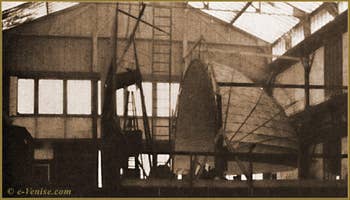
First tests of a mobile dome
Mariano Fortuny builds the Fortuny Cupola in Paris
Buoyed by this success, Mariano wasted no time in publicising his new lighting system when he travelled to Berlin in January 1901.In April of the same year, here he was in Paris where electric lighting was booming; in May he set up his studio on rue Washington, then on boulevard Berthier in 1902.
This was where he experimented with lighting, and where he developed his famous dome (a concave quarter-circle surface), used to complement indirect light in order to increase the effect of depth on the stage.
“Aided by a good workman, I built my plaster dome, five metres in diameter, where the indirect light was projected and other coloured lights were then scrolled across it; the effects of fusion, movement and variety of hues, could not fail to strike visitors.”
Fortuny
Mariano Fortuny's dome is appreciated by stage directors and by Sarah Bernhardt
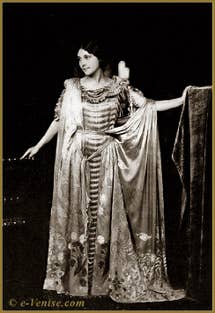
The “Delphos” dress. These admiring visitors included famous stage professionals Mr Kranich and the Swiss director Adolphe Appia, actors, and Sarah Bernhardt, the great star of the age.
It was in Paris, in 1902, that Mariano Fortuny met Henriette Nigrin, who was to become both his companion and above all his great collaborator in the manufacture of fabrics.
But they did not marry until 1924, still in Paris.
He had been in charge of the lighting and costumes for “Œdipus and the Sphinx” which was to be performed at the antique theatre in Orange, as well as the lighting at the Cercle de l'épatant in Paris.

Henriette Fortuny It was at this time that the comtesse du Béarn entrusted the staging of “Manfred” by Robert Schumann for her small private theatre to the Swiss Adolphe Appia, who went to Mariano's studio to ask him for some explanations about the lighting :
“Surprised and admiring my dome, Appia wanted to introduce me to the Countess of Béarn […] I made a model of the Valkyrie for Appia.
The countess realised that the stage of her theatre would be too small to accommodate my dome, and she immediately decided to have a new theatre built, annexed to the salon.
The architect in charge of the work, Mr Destailleur, simply had to follow my plans and drawings.”
Fortuny
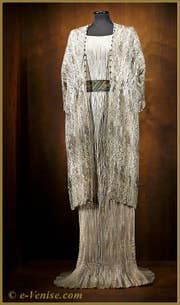
The Dress “Delphos ”
Mariano Fortuny works on stage direction with Adolphe Appia: light and colour
Mariano Fortuny and Adolphe Appia thus worked closely together on the new theatre of the Comtesse du Béarn on rue Saint Dominique, Paris.Both adhering to the Wagnerian utopia of the total work of art, the staging of Bayreuth seemed to them too crude to match the expressive power of the Master's music.
And sharing the same ideas, they rejected the grotesque use of skies painted on strips of canvas, as well as direct stage lighting which, by isolating the actor, only emphasised the artifices of his performance.
For Adolphe Appia and Mariano Fortuny direct lighting took into account neither the conformation of the human eye (and therefore its effect on the spectator), nor the problem of shadows.
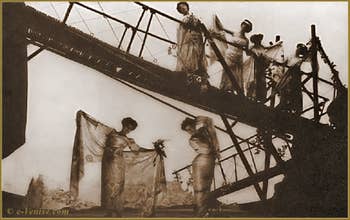
Coupole theatre Comtesse du Béarn
“Light is in the representative economy what music is in the score: the expressive element opposed to the sign; and like music, it can express nothing that does not belong to the intimate essence of all vision [...]
Now the direction of light is only visible to us through shadows; it is the quality of shadows that expresses for us the quality of light.
Shadows are thus formed by means of the same light as that which penetrates the atmosphere.”
Adolphe Appia
“As for the eye, the supreme goal, it is not even mentioned, nor is it taken into account: the technician is not concerned with the quantity of light entering the eye, the only useful one, but only with that which has remained outside and therefore useless, and even non-existent.”
Mariano Fortuny - “Theatre and Light”
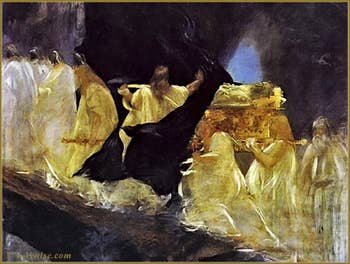
Fortuny, Richard Wagner's Parsifal And even if a little later Appia abandoned the criteria of realistic imitation and illusion that captivate the spectator in favour of a show conceived as a free experiment, he nonetheless remained grateful and admiring of the invention of the dome and indirect lighting with its unlimited colour possibilities. He said that it had liberated the director by giving him a palette equivalent to that of a painter.
Mariano Fortuny's inflatable dome and sets are a triumph
Perfectly aware of the value of his work, Mariano Fortuny always took precautions by filing a patent with the Office National de la Propriété Industrielle in Paris each time.- February 1903: patent for a “Theatrical decoration apparatus”.
- April 1904: patent for a “System for forming a concave wall by means of an inflatable capacity”.
The novelty lay in the fact that the dome wall was no longer made of plaster, but was :
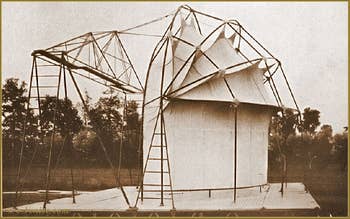
The dome of the Carro di Tespi
“Consisting of two parallel fabric surfaces supported by a metal frame hinged like a car top, between which a fan was placed.
The pressure of the air passing between the two walls made the wall facing the stage perfectly smooth.”
Fortuny
Lightweight and articulated, it deployed in a matter of moments.
Easily transportable, it would later be exploited by the travelling theatre, the “Carro di Tespi”, by Giovacchino Forzano in Italy.
It was precisely this type of inflatable dome that Mariano Fortuny installed in the new theatre of the Comtesse du Béarn, for which he had drawn up the plans so that it could be installed there: 15 metres high by 10 metres open and 17 metres deep, equipped with indirect lighting.
On 29 March 1906, the day the theatre was inaugurated with a performance of a ballet by Charles-Marie Widor before an audience of diplomats, men of letters and other personalities, it was a triumph.
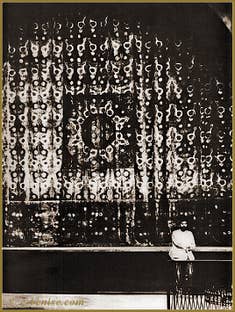
Fortuny Comtesse du Béarn
“...no backdrop, but a vast dome of white fabric; you'd think you were inside a balloon.
Depending on whether tinted silk or glass with clouds painted on it passes in front of the focus of light, the dome becomes coloured or animated.
Successively we had the blue sky of a June morning, the first symptoms of a thunderstorm, then sunset.
We are in reality; in nature itself; this dome is the cap of the sky, the limitless horizon, the air we breathe, the atmosphere, life.
My very brief description will no doubt evoke the idea of a certain analogy with the magic lantern [...].
It involves projections onto a canvas like the primitive toy that charmed our childhood [...].
The chief electrician directs everything, making light or shade, calm or storm, changing from red to blue, yellow to grey as the drama develops, according to the author's thoughts [...] a show that is so realistic and so poetic at the same time.
On 29 March 1906, theatrical painting entered the realm of music for the first time, that is to say in time, whereas until then it had only been able to develop in space. Let us remember this date, which will go down in the history of the theatre”
M. Widor - “The Minstrel” - 15 April 1906
Mariano Fortuny invents the first stage management booth
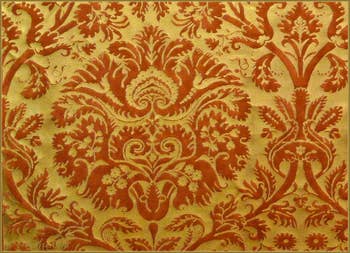
Fabric Mariano Fortuny “de Medici” In fact, Mariano Fortuny had invented the first control booth, where the lighting designer had a series of switches that controlled the lights allowing him to send all the desired lighting effects from there.
Each of them was numbered; by noting them in a given order, it was then easy to reproduce exactly the desired effect at each show.
And for the first time the stage was overhung by a double catwalk where the stagehands could install the light sources; there was also a mechanism for raising or lowering the stage.
On this day, with a magnificent stage curtain made of Italian-style velvet using his own technique, Mariano Fortuny also revealed his talents in fabric printing.
The international success of the cupola - Mariano Fortuny's theatrical reform in Germany
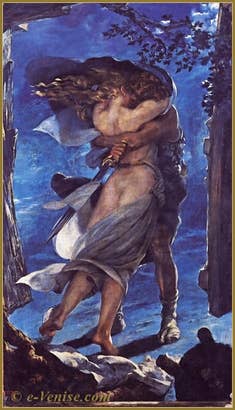
The Valkyrie: The Embrace German Emperor Wilhelm II had sent the director of the theatre in Wiesbaden to Paris to visit Mariano's studio.
And, through Max Reinhardt then director of the Künstler Theater in Berlin, the German company AEG soon got in touch with him to market its indirect lighting system.
The Beleuchtung System Fortuny GmbH (Fortuny Lighting System Ltd) with headquarters in Berlin was founded as early as May 1906 with the participation of Mariano Fortuny.
The latter closely followed the installation of the dome at the Kroll theatre in Berlin in 1908.
The one at the Künstler Theater was not built by AEG, because the impatient Max Reinhardt decided to build it himself.
Other domes were subsequently installed in Germany in Charlottenburg, Dresden, Duisburg, Karlsruhe, Königsberg, Stuttgart, Wiesbaden by AEG, which from the outset had wanted to eliminate any trace of artisanal dilettantism in the construction of its domes.
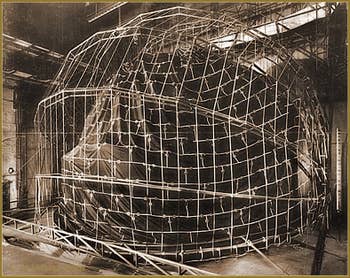
Mariano Fortuny cupola All these technical improvements, brought in by AEG for production reasons, displeased Mariano Fortuny, artist and demiurge, who saw his invention transformed into a mere industrial product subject to the laws of the market.
And the members of the AEG company had ended up annoying him, so much so that he was no longer directly involved in the work.
The German experience brought him face to face with a reality that was beyond him.
Hugo Von Hoffmanstahl, whom he had met in Berlin in 1907, did not appreciate the interference of commercialism in art either.
Shortly after their meeting, he had asked her to handle the set design for his second electron. But the project never came to fruition.
Project to build an open-air theatre on the Esplanade des Invalides in Paris
Mariano Fortuny longed to one day be able to realise his “total work of art” with a theatre equipped with its own dome and lighting system, for which he would create the sets, and make the costumes from his own fabrics.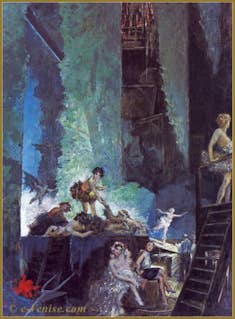
Rehearsal at La Scala Milan The opportunity to present this fine unit to the discerning public was about to come to fruition in 1907, when he and his great friend Gabriele d'Annunzio, in association with the architect Hess, founded a company to build and operate an open-air theatre on the Esplanade des Invalides in Paris.
This was to be the “Théâtre des Fêtes”, where d'Annunzio's works would be performed as a priority, in line with his desire to promote Latin literature.
The funds were guaranteed in part by the protagonists, but also by Baron Rothschild and Senator Deutsch de la Meurthe.
By the time the company's incorporation deed was signed, Gabriele d'Annunzio had left for Arcachon with his latest conquest, without telling anyone! Another failed project with d'Annunzio.
Even though the two friends liked and esteemed each other very much, they nevertheless never managed to carry out an artistic project together.
Gabriele d'Annunzio had come to appreciate the wonderful work of Mariano Fortuny, and did not fail to mention it in his novel entitled “Forse che si, forse che no”.
Fortuny Museum Fortuny | Martinengo Orfei | Theatre | Clothes Fabrics | Photography Costume
Painters Tintoretto | Titian | Canaletto | Fortuny | Albrecht Dürer |
Art Painters | Music | Literature | Video | Pictures
Back to Top of Page


